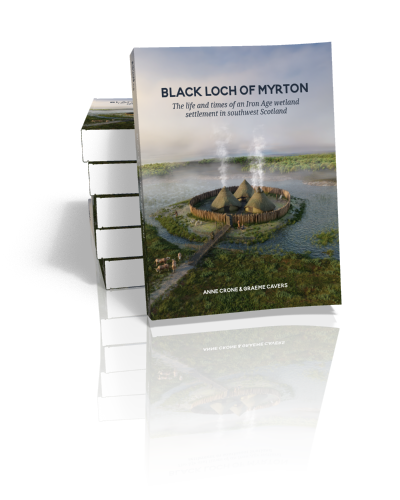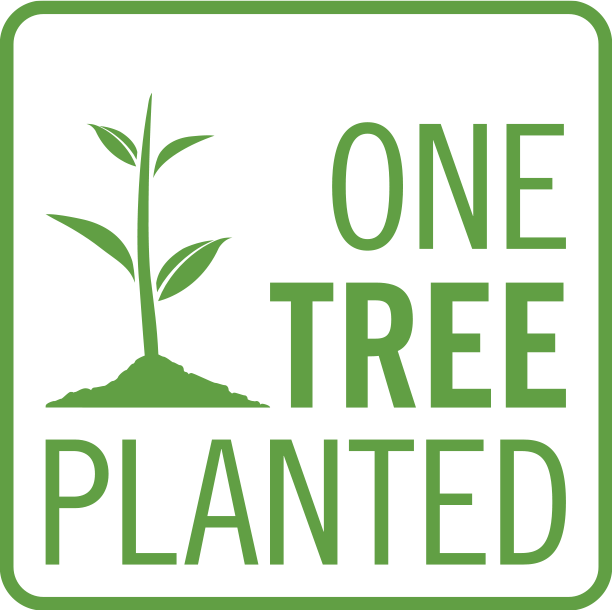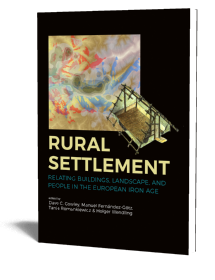Abstract:
This monograph presents the results of excavations at an Iron Age wetland settlement at Black Loch of Myrton (BLM), located on the Machars peninsula in Wigtownshire, Scotland. Although first noted in the 1880s, the site remained unexamined until its rediscovery during modern drainage work. Excavations were carried out between 2013 and 2019 as part of the Scottish Wetland Archaeology Programme (SWAP), supported by Historic Environment Scotland and the UK Arts and Humanities Research Council. The project used a multidisciplinary approach, combining dendrochronology, radiocarbon dating, micromorphology, and multi-proxy environmental analyses.
The settlement, built on a natural peat island in a small loch, revealed three main episodes of occupation between the mid-5th and early 2nd century BCE. The earliest phase (c. 437 BCE) featured a log trackway, defensive palisades, and roundhouses. Around 425–420 BCE, the site expanded beyond the original boundaries with new roundhouses and an earthen rampart. A third phase (starting c. 278 BCE) involved substantial reconstruction of the perimeter defences using oak planks and palisades.
Excavation revealed exceptionally well-preserved wooden structures, hearths, and organic floor deposits. These finds allowed detailed reconstructions of domestic life, construction techniques, and the site’s interaction with its environment. The site’s deep stratigraphy and ecofactual remains – including plants, insects, animal bones, and lipid biomarkers – offer unique insights into living conditions, resource use, and spatial organisation.
Thanks to precise dating through dendrochronology and radiocarbon modelling, the research demonstrates that wetland settlements were an integral part of Iron Age life in northern Britain. These findings reshape our understanding of settlement patterns, defence, and resource management during the mid to late first millennium BCE.
Contents
Chapter 1 Introduction
Chapter 2 Chronology
Chapter 3 Episode 1
Chapter 4 Episode 2
Chapter 5 Post-ST2 activity
Chapter 6 Episode 3
Chapter 7 Specialist Reports – Dendrochronology
Chapter 8 Specialist Reports – Radiocarbon dating and Bayesian chronological modelling
Chapter 9 Specialist Reports – Micromorphology
Chapter 10 Specialist Reports – Faecal steroid biomarkers
Chapter 11 Specialist Reports – Plant macrofossils
Chapter 12 Specialist Reports – Faunal remains and shellfish
Chapter 13 Specialist Reports – Insect remains
Chapter 14 Specialist Reports – Wood use and woodworking
Chapter 15 The artefacts
Chapter 16 Investigations on the crannog in the White Loch of Myrton
Chapter 17 The physical environment of the settlements
Chapter 18 Reflections


Dr.
Anne Crone
Anne Crone is an archaeologist and dendrochronologist. After a PhD in dendrochronology at the University of Sheffield she has spent her working career as a Project Manager for AOC Archaeology Group, Edinburgh establishing and running their dendrochronology facility, and undertaking research and excavation on wetland settlements throughout Scotland. She has authored and co-authored monographs on several crannog excavations
read more


Dr.
Graeme Cavers
Graeme Cavers is a director at AOC Archaeology Group in the UK. He specialises in the later prehistoric settlements of northern Britain, having completed doctoral research on the crannogs of western Scotland, and has coordinated surveys and excavations at Iron Age settlements across Scotland, including at Cults Loch and Whitefield Loch in Wigtownshire, Nybster broch in Caithness and Clachtoll broch in Assynt. He is an honorary Research Associate at the University of Edinburgh, UK.
read more













